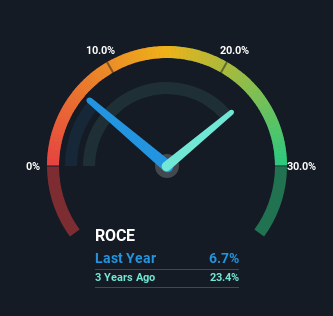Returns At Symtek Automation Asia (TWSE:6438) Are On The Way Up
Did you know there are some financial metrics that can provide clues of a potential multi-bagger? Ideally, a business will show two trends; firstly a growing return on capital employed (ROCE) and secondly, an increasing amount of capital employed. If you see this, it typically means it's a company with a great business model and plenty of profitable reinvestment opportunities. So on that note, Symtek Automation Asia (TWSE:6438) looks quite promising in regards to its trends of return on capital.
Return On Capital Employed (ROCE): What Is It?
For those that aren't sure what ROCE is, it measures the amount of pre-tax profits a company can generate from the capital employed in its business. Analysts use this formula to calculate it for Symtek Automation Asia:
Return on Capital Employed = Earnings Before Interest and Tax (EBIT) ÷ (Total Assets - Current Liabilities)
0.067 = NT$401m ÷ (NT$8.6b - NT$2.6b) (Based on the trailing twelve months to December 2024).
Therefore, Symtek Automation Asia has an ROCE of 6.7%. In absolute terms, that's a low return but it's around the Machinery industry average of 8.4%.
Check out our latest analysis for Symtek Automation Asia

Historical performance is a great place to start when researching a stock so above you can see the gauge for Symtek Automation Asia's ROCE against it's prior returns. If you're interested in investigating Symtek Automation Asia's past further, check out this free graph covering Symtek Automation Asia's past earnings, revenue and cash flow.
How Are Returns Trending?
Even though ROCE is still low in absolute terms, it's good to see it's heading in the right direction. The numbers show that in the last five years, the returns generated on capital employed have grown considerably to 6.7%. The company is effectively making more money per dollar of capital used, and it's worth noting that the amount of capital has increased too, by 162%. The increasing returns on a growing amount of capital is common amongst multi-baggers and that's why we're impressed.
In Conclusion...
In summary, it's great to see that Symtek Automation Asia can compound returns by consistently reinvesting capital at increasing rates of return, because these are some of the key ingredients of those highly sought after multi-baggers. And with the stock having performed exceptionally well over the last five years, these patterns are being accounted for by investors. In light of that, we think it's worth looking further into this stock because if Symtek Automation Asia can keep these trends up, it could have a bright future ahead.
If you'd like to know more about Symtek Automation Asia, we've spotted 3 warning signs, and 1 of them is a bit concerning.
While Symtek Automation Asia isn't earning the highest return, check out this free list of companies that are earning high returns on equity with solid balance sheets.
New: Manage All Your Stock Portfolios in One Place
We've created the ultimate portfolio companion for stock investors, and it's free.
• Connect an unlimited number of Portfolios and see your total in one currency
• Be alerted to new Warning Signs or Risks via email or mobile
• Track the Fair Value of your stocks
Have feedback on this article? Concerned about the content? Get in touch with us directly. Alternatively, email editorial-team (at) simplywallst.com.
This article by Simply Wall St is general in nature. We provide commentary based on historical data and analyst forecasts only using an unbiased methodology and our articles are not intended to be financial advice. It does not constitute a recommendation to buy or sell any stock, and does not take account of your objectives, or your financial situation. We aim to bring you long-term focused analysis driven by fundamental data. Note that our analysis may not factor in the latest price-sensitive company announcements or qualitative material. Simply Wall St has no position in any stocks mentioned.
About TWSE:6438
Symtek Automation Asia
Manufactures and sells automation equipment and related products in Taiwan, China, and the United States.
Flawless balance sheet with proven track record.
Market Insights
Community Narratives




